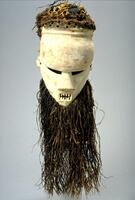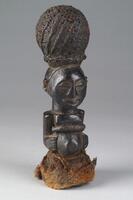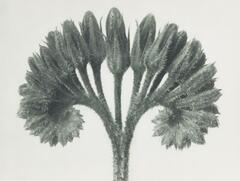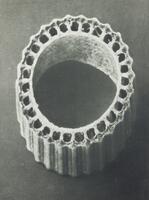11 UMMA Objects
11 UMMA Objects

Salampasu (Salampasu)
Mask (Kasangu)
1920 – 1960
Museum Purchase assisted by the Friends of the Museum of Art
1971/2.44

Dan
Face Mask
1800 – 1999
Gift of the Robbins Center for Cross Cultural Communications in memory of Warren M. Robbins
2014/2.24

Luba (Luba (culture or style))
Carved Wood Figure
1945 – 1955
Given in memory of Sidney H. Roberts
1987/1.242
![A bundle of thin fibres (which form the brush) held together by thin strips of wood wrapped around one half of the bundle, topped with a piece of cloth to create a cap.<br />
<br />
This brush was used in a procedure called bemaegi , which involves starching fabric to level threads on the surface of the warp and maintain humidity. It was made of pine roots and by binding them together at the end of the handle with hemp cloth.
<p>[Korean Collection, University of Michigan Museum of Art (2017) p. 279]</p>
A bundle of thin fibres (which form the brush) held together by thin strips of wood wrapped around one half of the bundle, topped with a piece of cloth to create a cap.<br />
<br />
This brush was used in a procedure called bemaegi , which involves starching fabric to level threads on the surface of the warp and maintain humidity. It was made of pine roots and by binding them together at the end of the handle with hemp cloth.
<p>[Korean Collection, University of Michigan Museum of Art (2017) p. 279]</p>](/media/W1siZiIsIjIwMjIvMDkvMjQvOHdjZ3d1azVrdF9kZWZhdWx0LmpwZyJdLFsicCIsInRodW1iIiwiMjQweDIwMCJdXQ?sha=88d372e313e26601)
Korean (Korean (culture or style))
Brush
1900 – 1950
Gift of Ok Ja Chang and the Chang Family
2009/2.52

Chinese (Chinese (culture or style))
Bulbs in Flower Pot
20th century
Gift of Doris and Herbert Sloan
1998/2.42

1800 – 1999
Gift of the Robbins Center for Cross Cultural Communications in memory of Warren M. Robbins
2014/2.73

Karl Blossfeldt (German (culture or style))
Symphytum officinale
1928
Gift of Eeta Gershow
2014/2.12
Loading…




